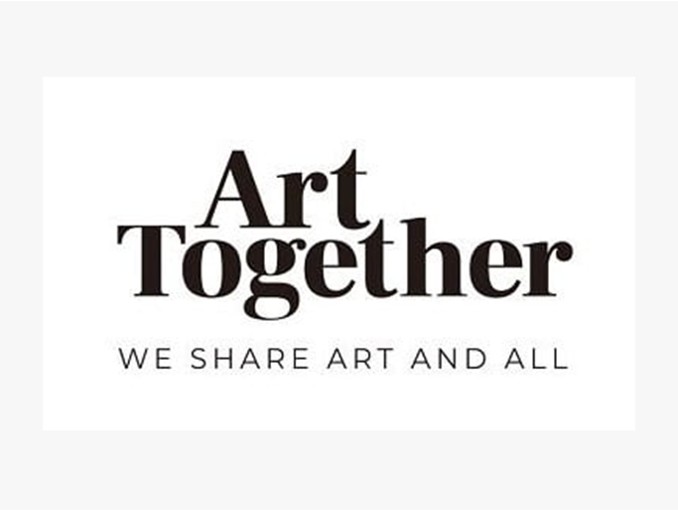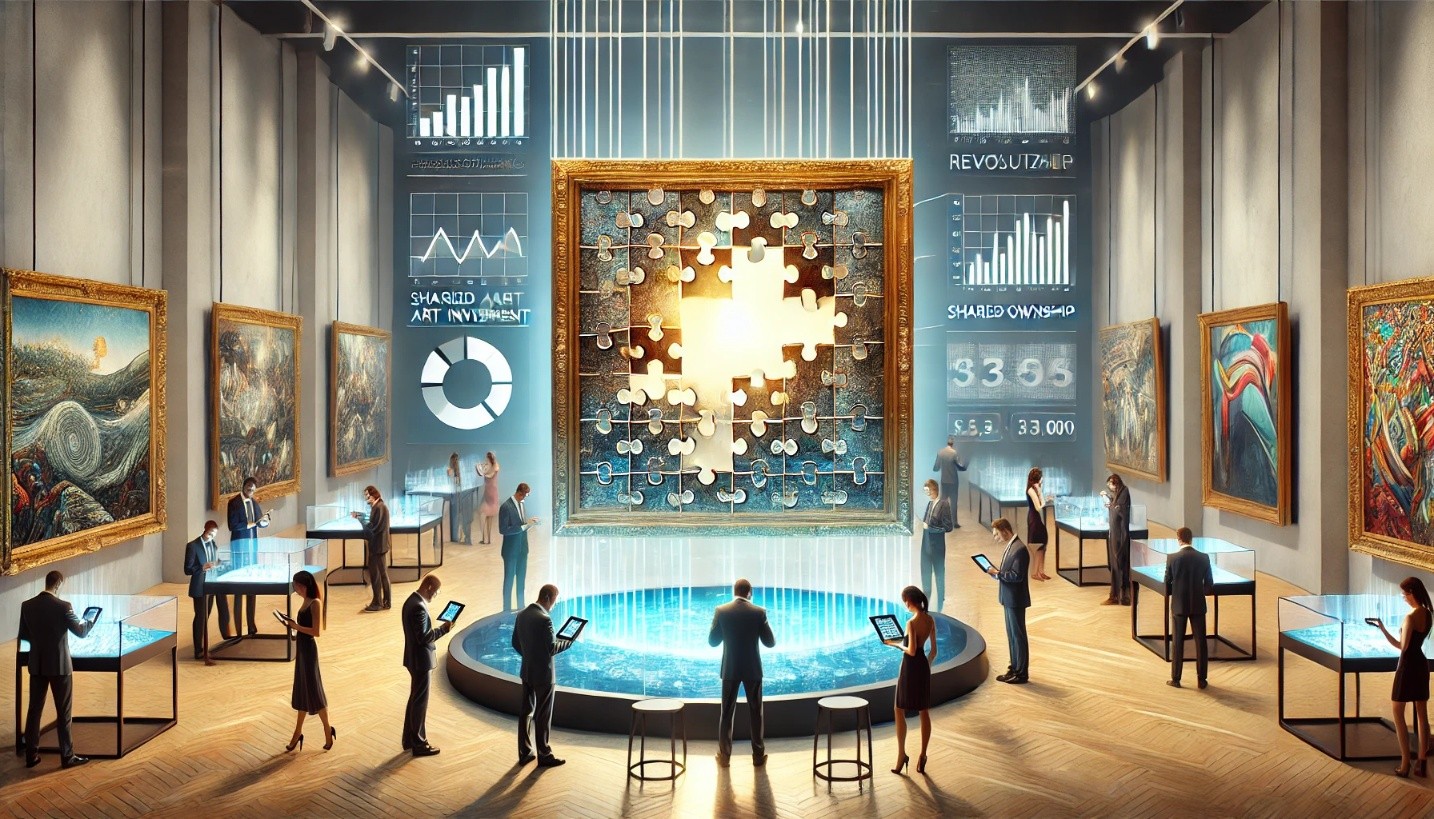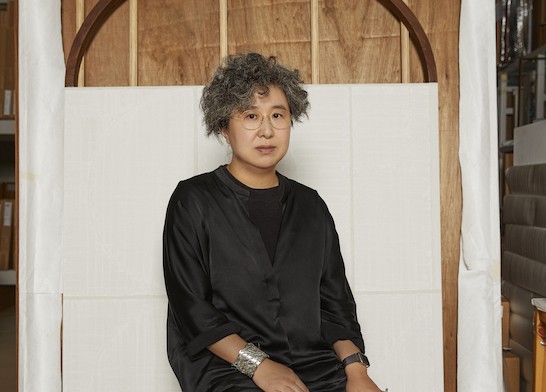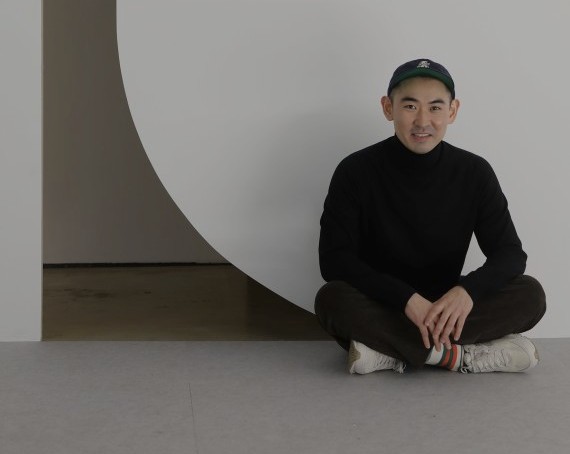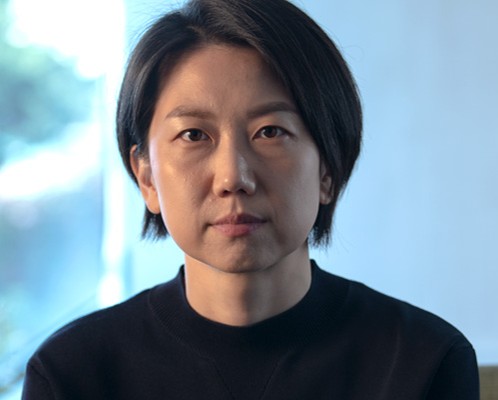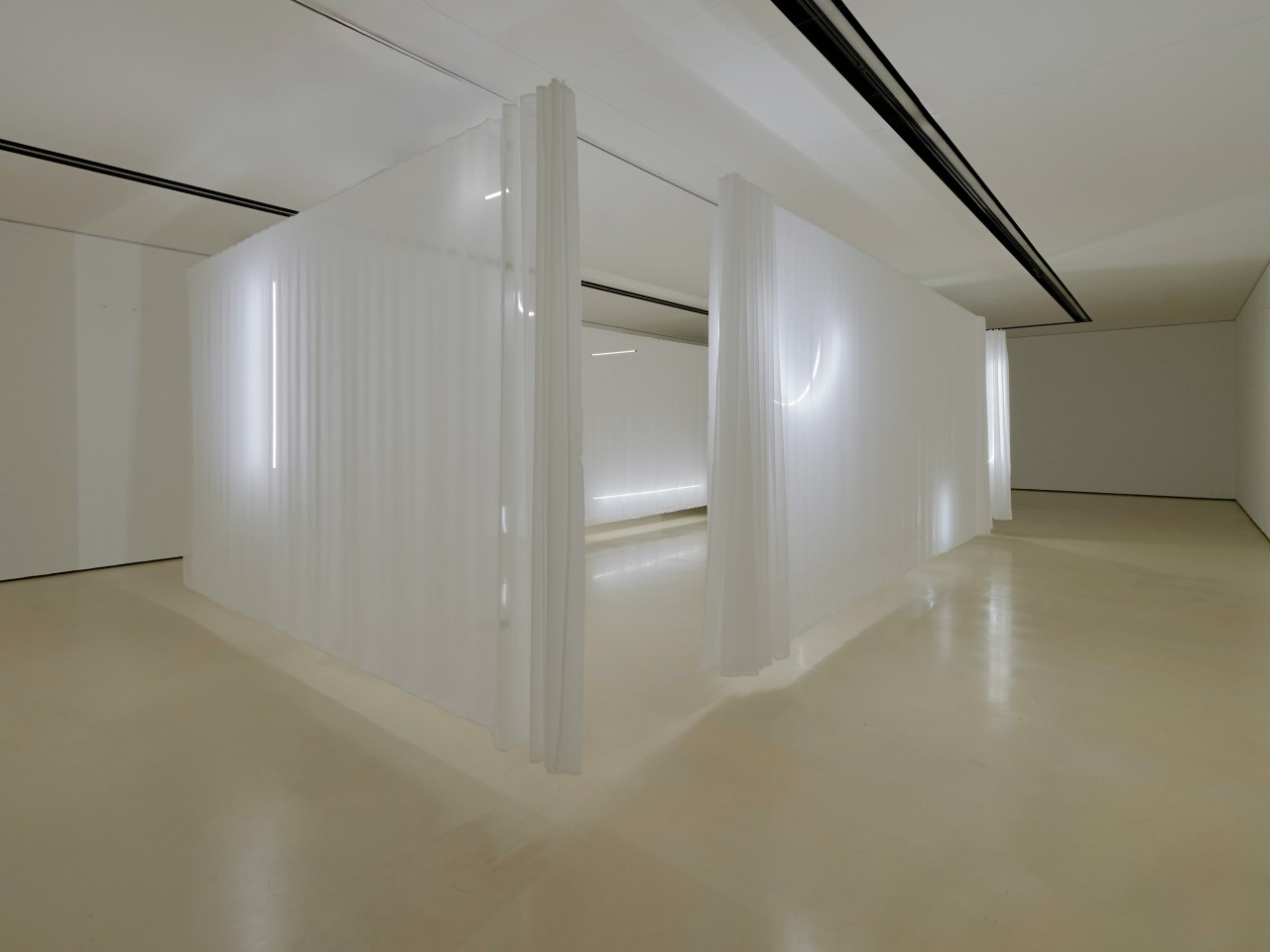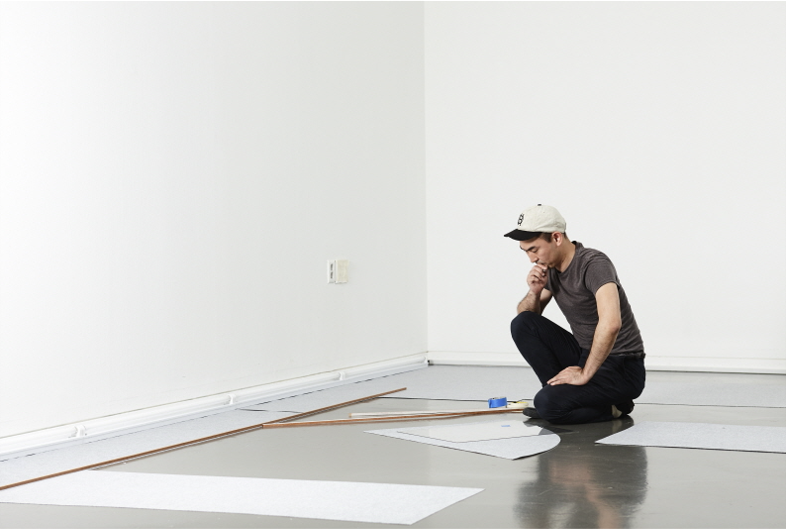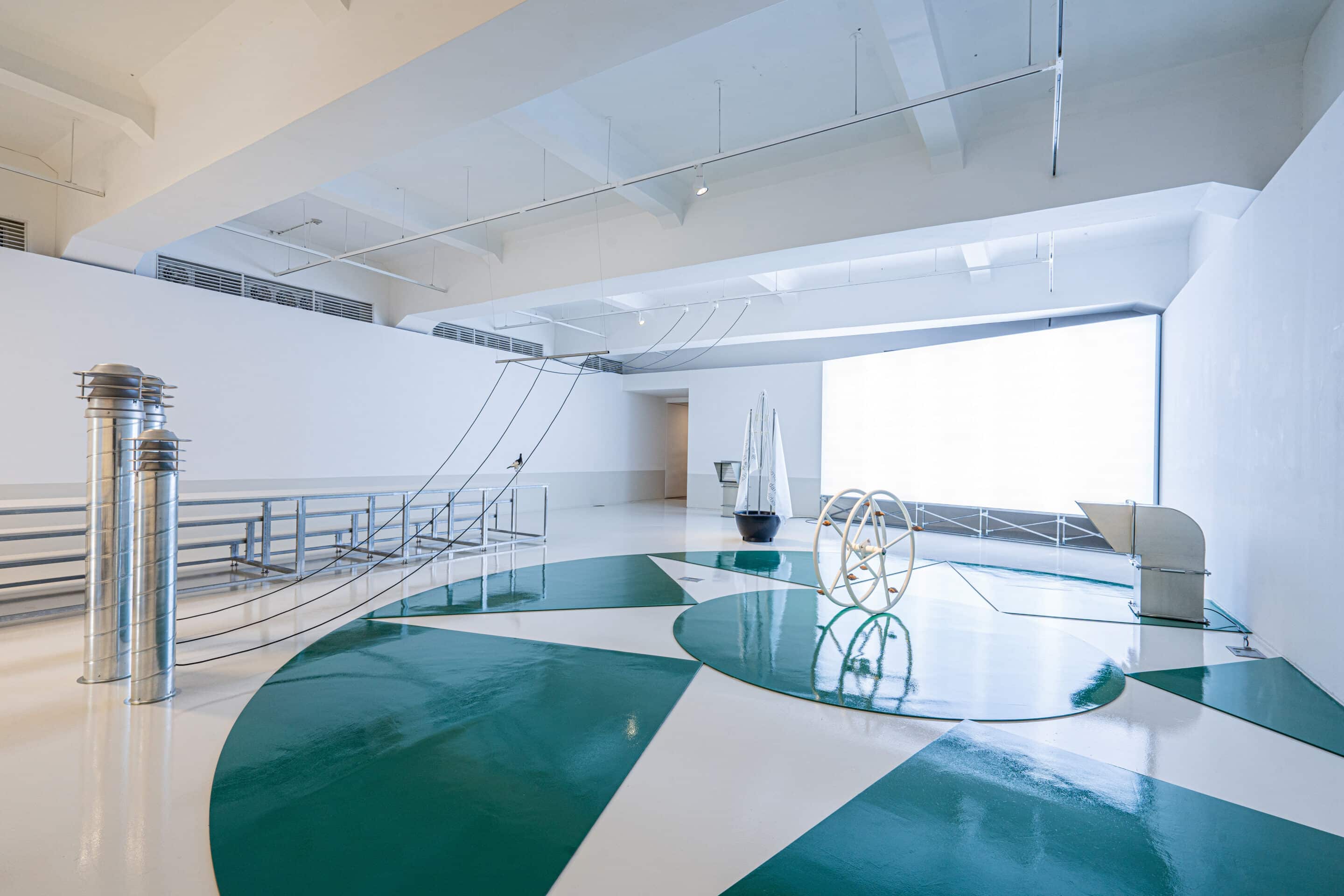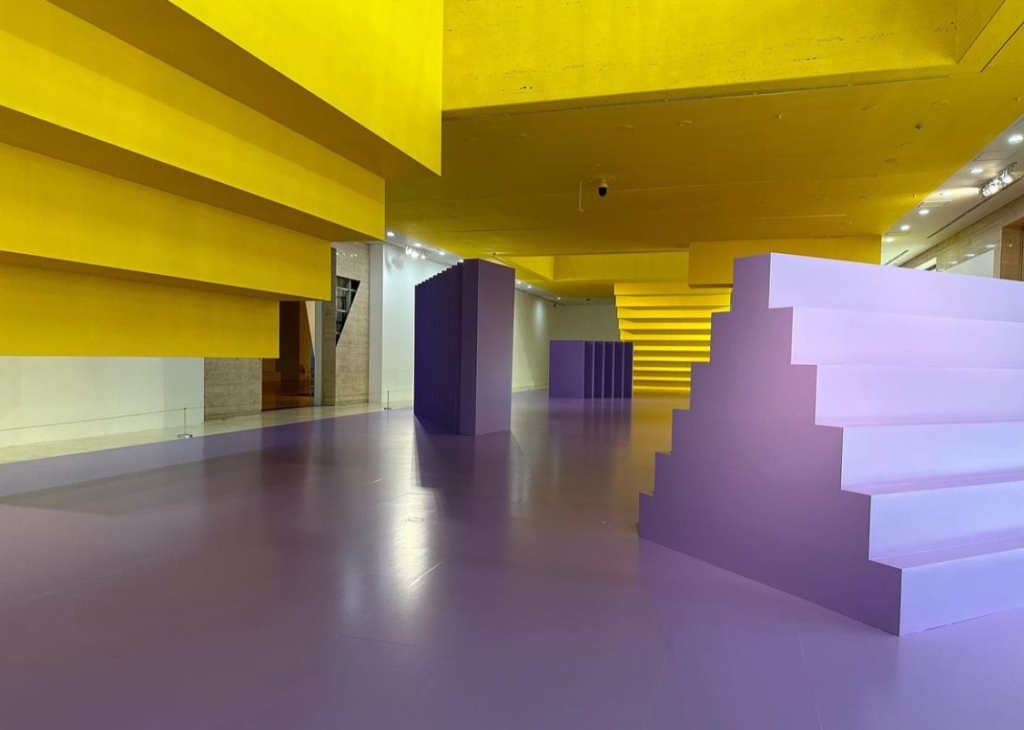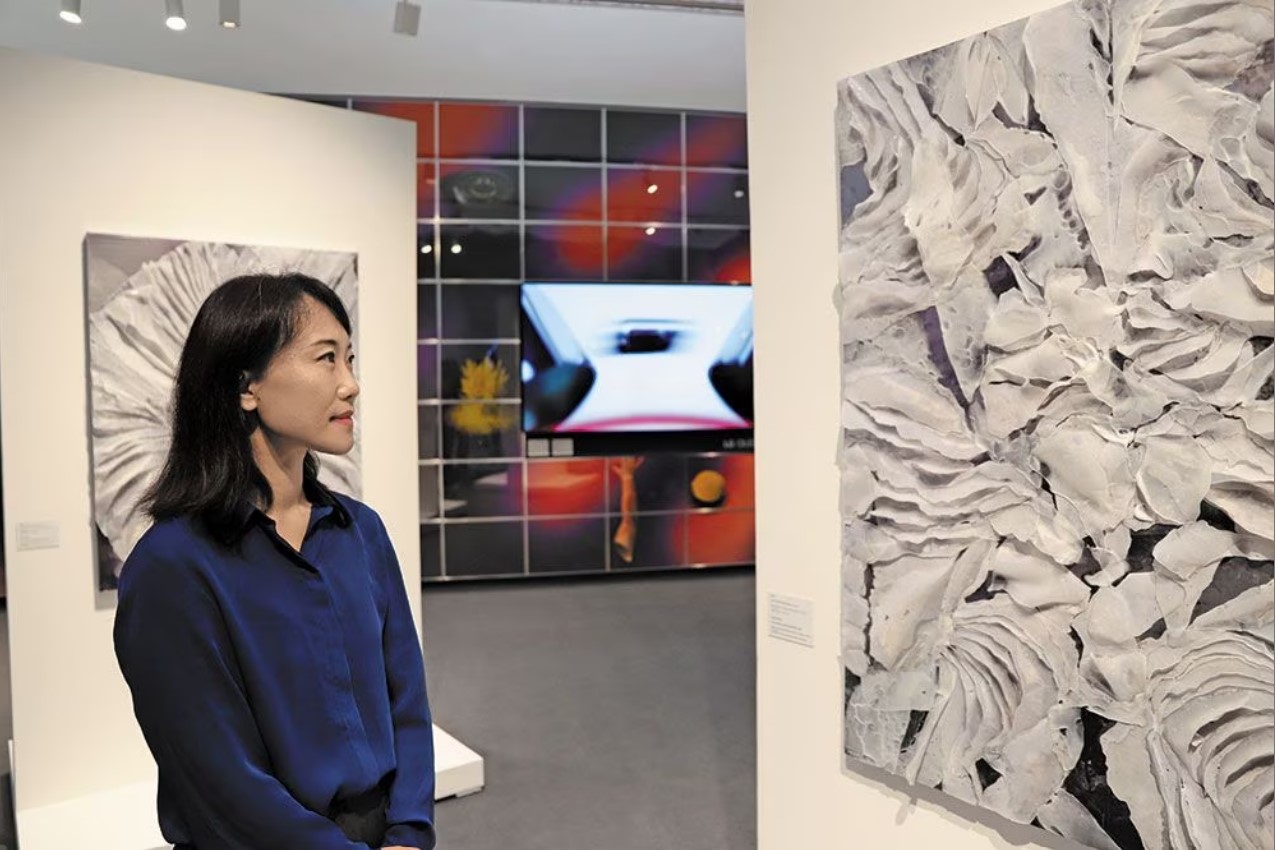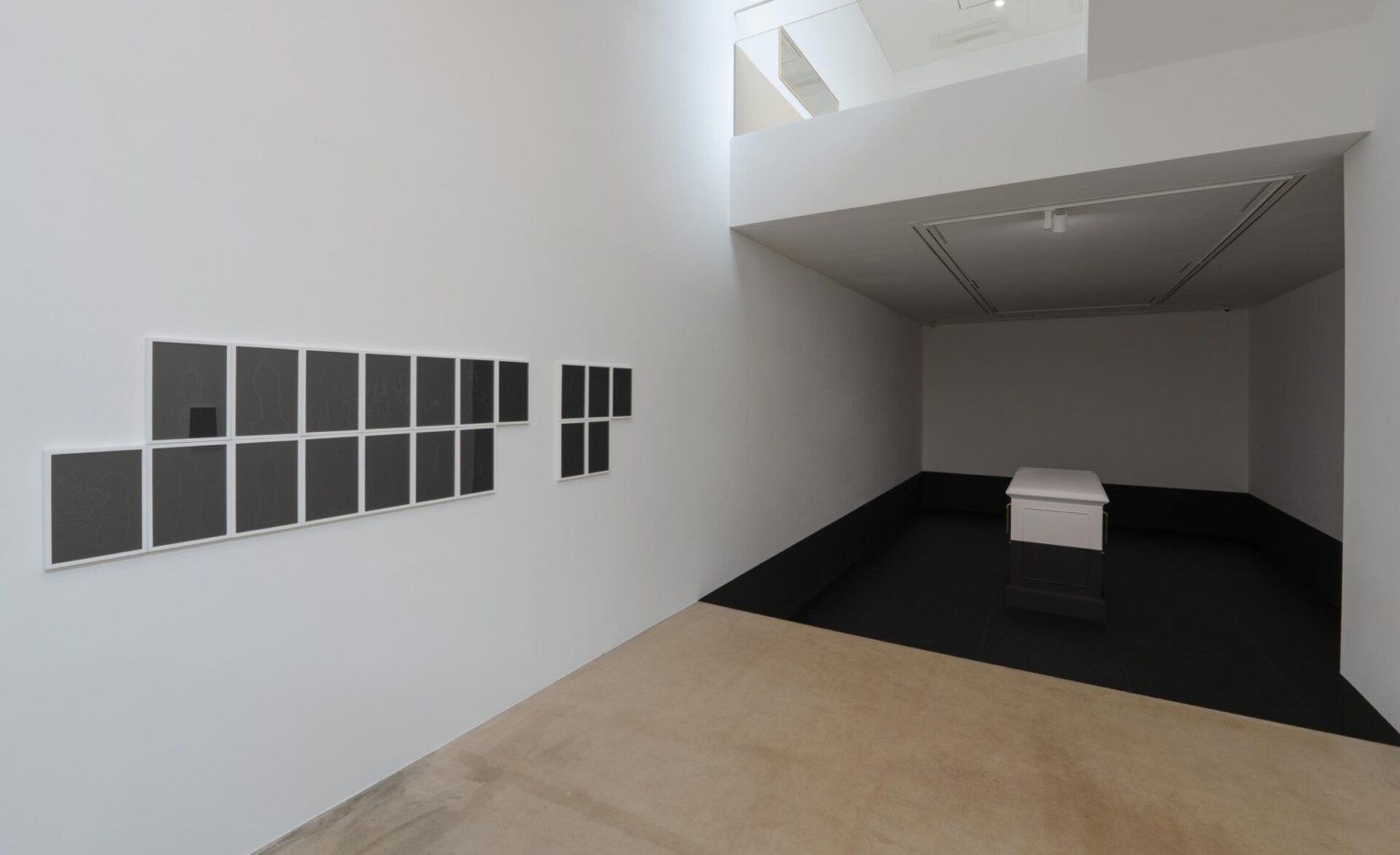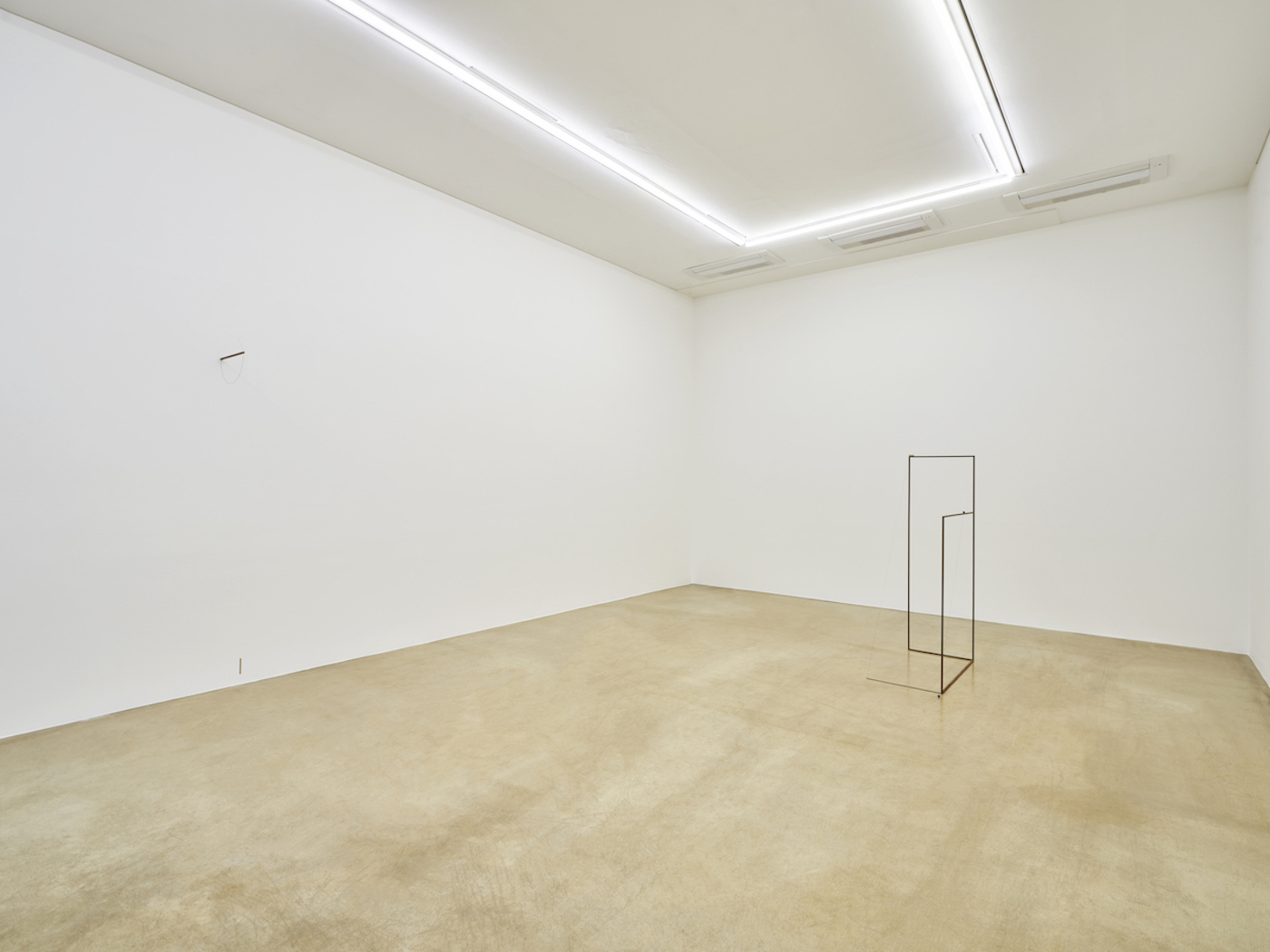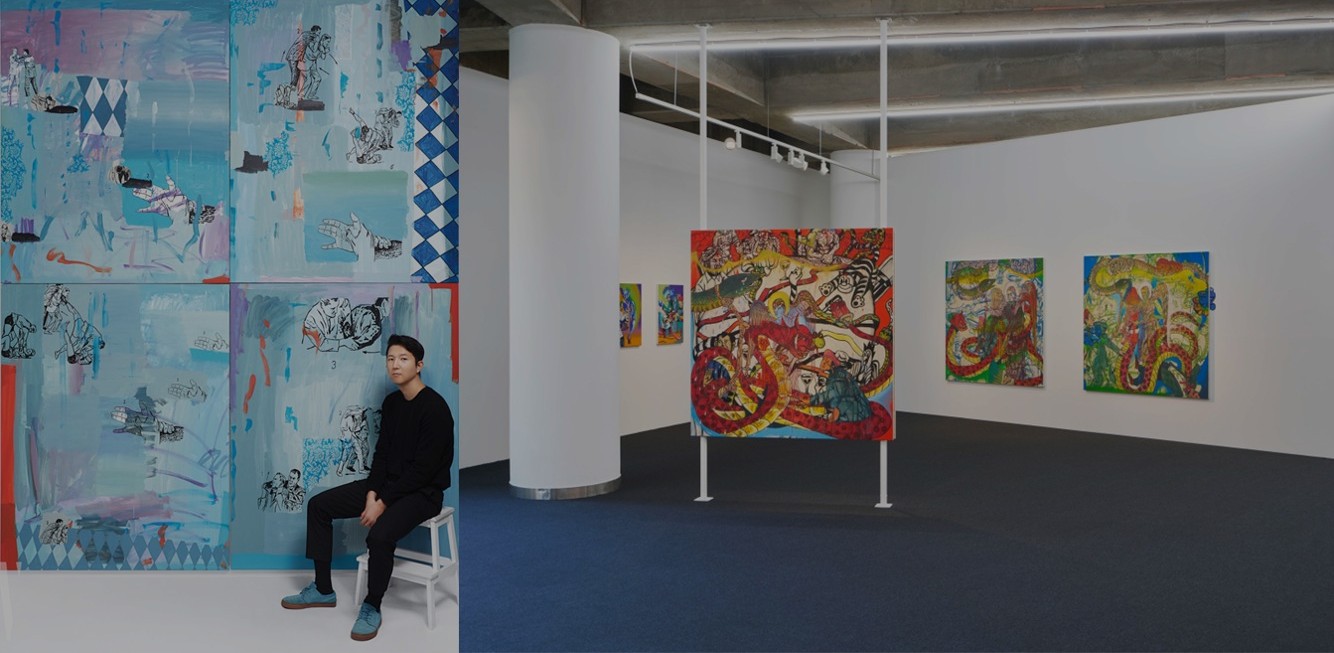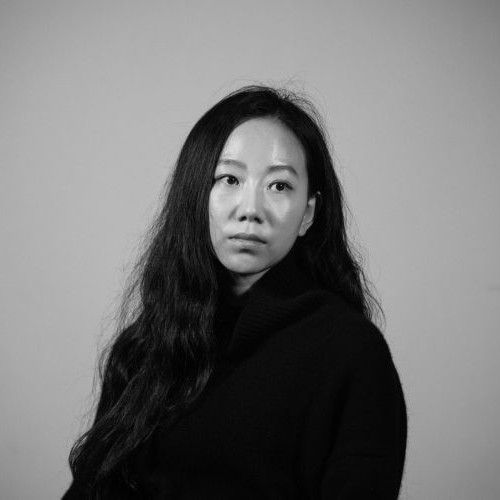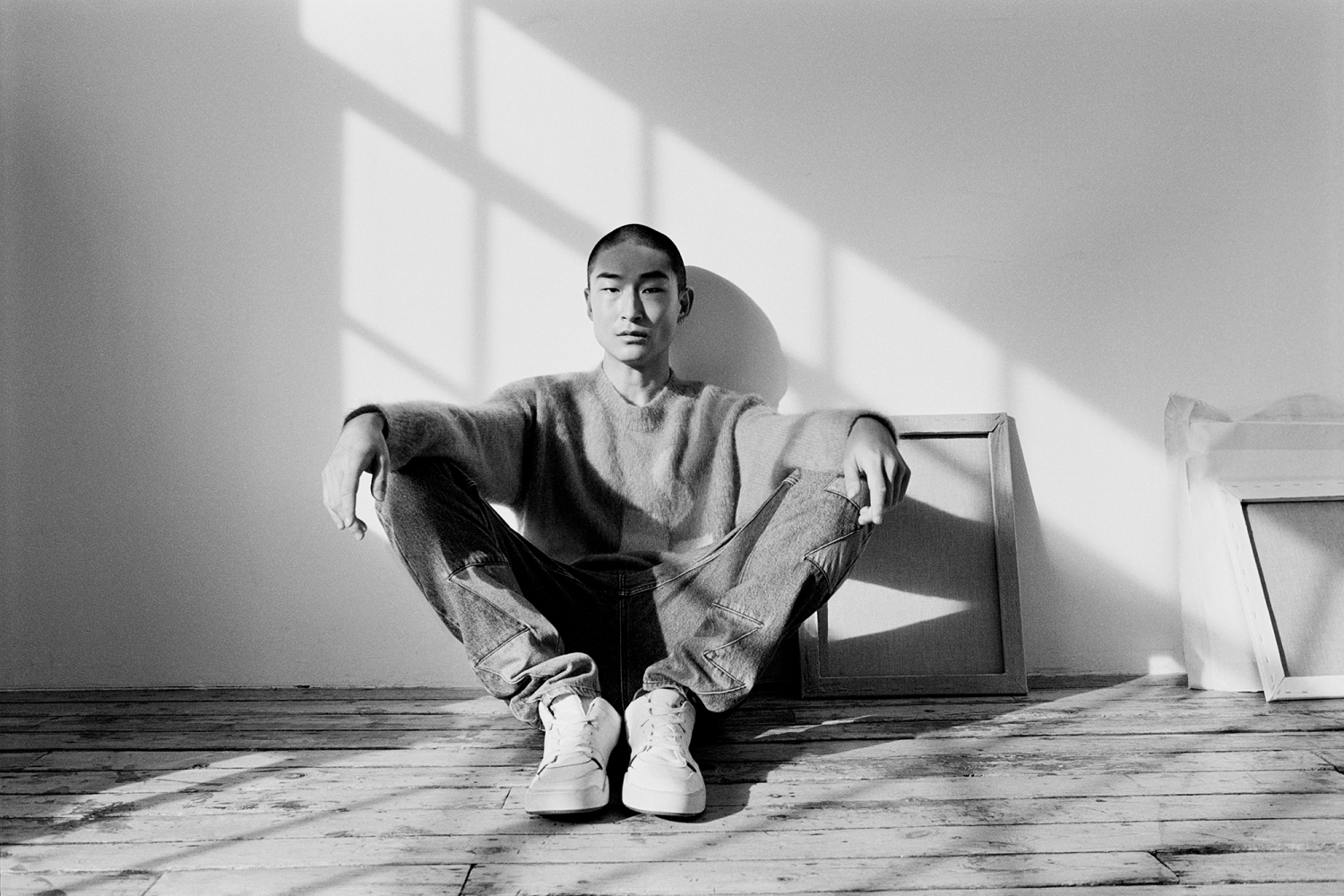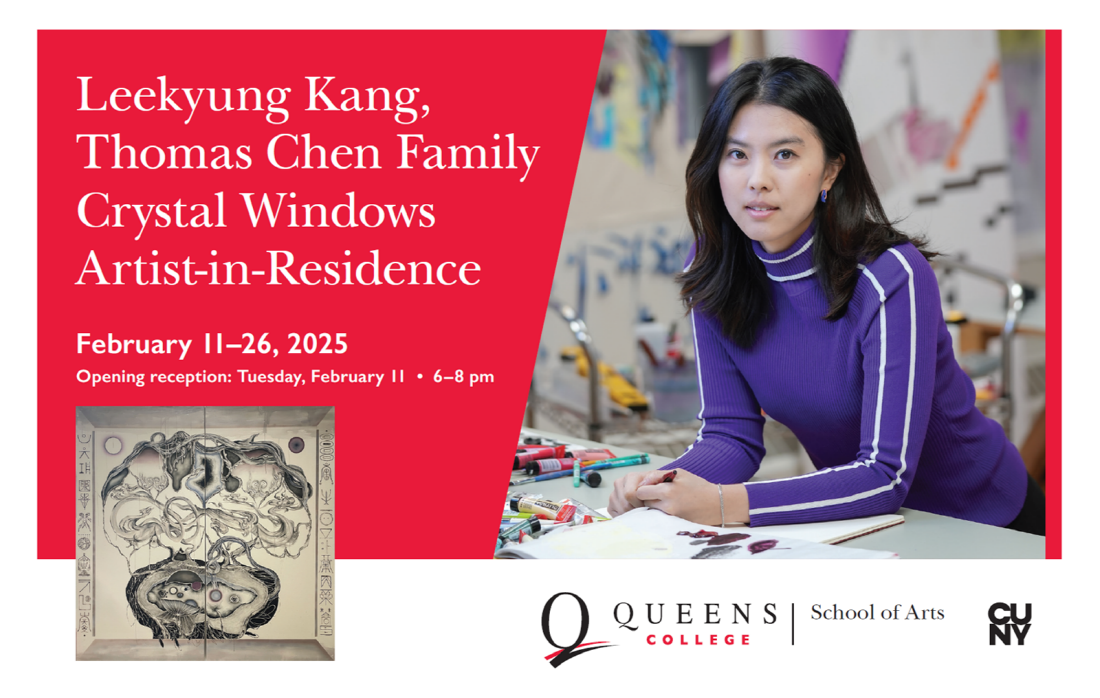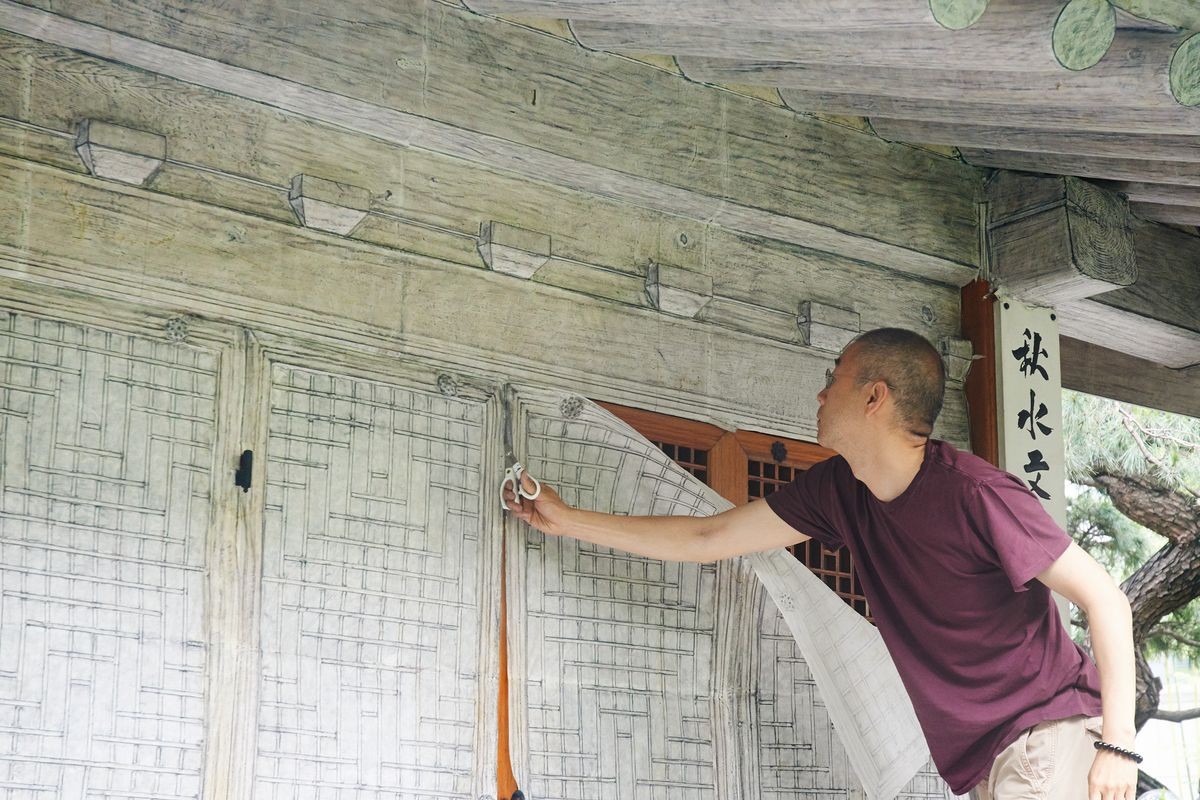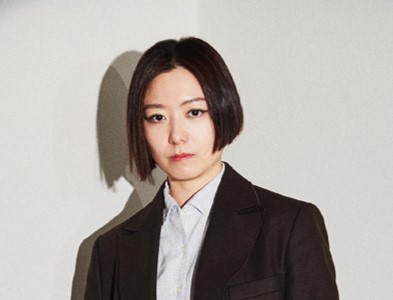Jong Oh (b. 1981) has been creating works
that sculpturally visualize the architectural elements of a given space and the
invisible sensations inherent within it. His practice employs minimal materials
such as fine threads, lightweight chains, and thin wires, inviting a fresh
perception of objects and the spaces that surround them.
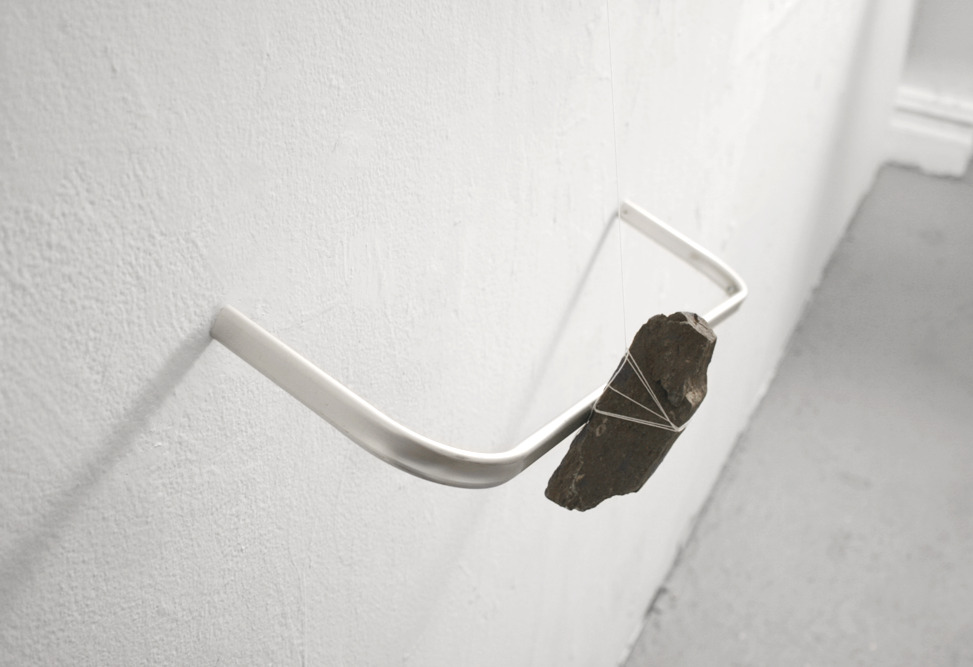 Jong Oh, Pushed,
2009 ©Jong Oh
Jong Oh, Pushed,
2009 ©Jong OhBeginning in 2009, Jong Oh's early ‘Found
gesture’ series centers on everyday objects discovered in his surroundings. The
artist collects items such as stones encountered on the street, makeup brushes,
wood, and chairs, then deconstructs their forms or utilizes their materiality
sculpturally to transform them into new objects that harmonize with the
physical conditions of the exhibition space.
While the material characteristics of these
objects play a significant role in his works, the artist simultaneously
incorporates the invisible force of gravity and its unstable nature into his
installations. For instance, by introducing mechanisms that counteract or
interact with gravity’s pull, which directs weighted objects downward, he
evokes subtle tension and harmony within the space.
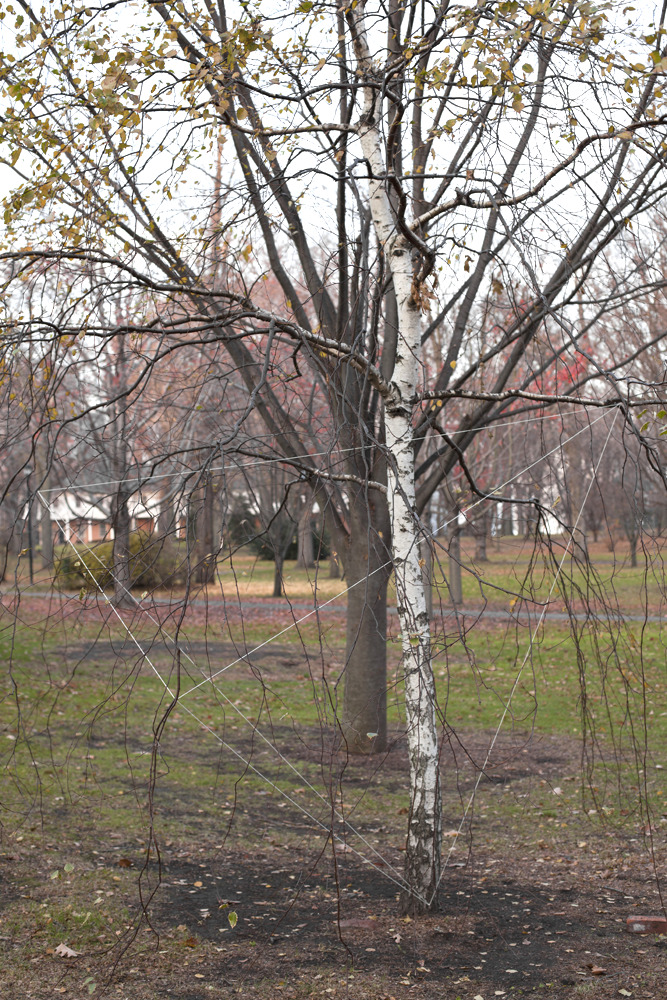
Jong Oh, Treeangle 2, 2012 ©Jong Oh
Another early work by Jong Oh,
Treeangle (2012), is a site-specific project centered on
trees in an outdoor park. This work stemmed from the artist’s contemplation of
what could be done within an already existing place and structure such as
“nature.”
Focusing on the elasticity of tree
branches, Oh installed barely visible fine threads stretched taut across the
branches. Treeangle, which reveals itself only upon close
inspection, resembles geometric line drawings that blend harmoniously with the
organic forms of the branches, evoking an extraordinary experience in a
familiar setting.
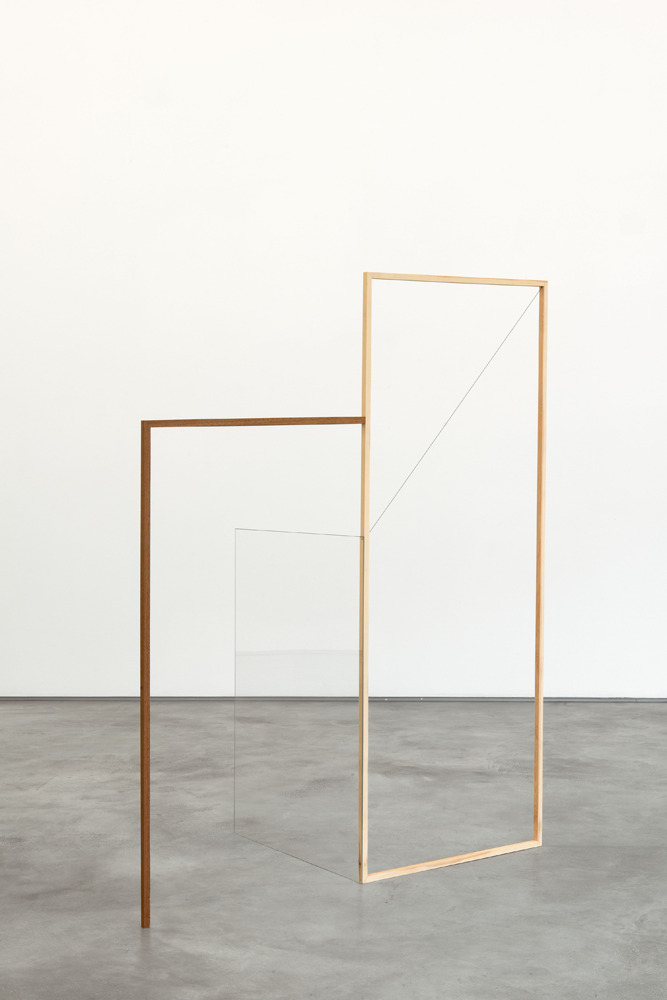
Jong Oh, Line Sculpture #4, 2013 ©Jong Oh
Jong Oh's ‘Line Sculpture’ series (2013–)
highlights sculptural elements by utilizing simple materials such as thread,
wooden sticks, and pencil lines to create three-dimensional geometric forms.
The delicate frames of these sculptures visually partition portions of the
exhibition space, temporarily defining condensed internal spaces within the
works.
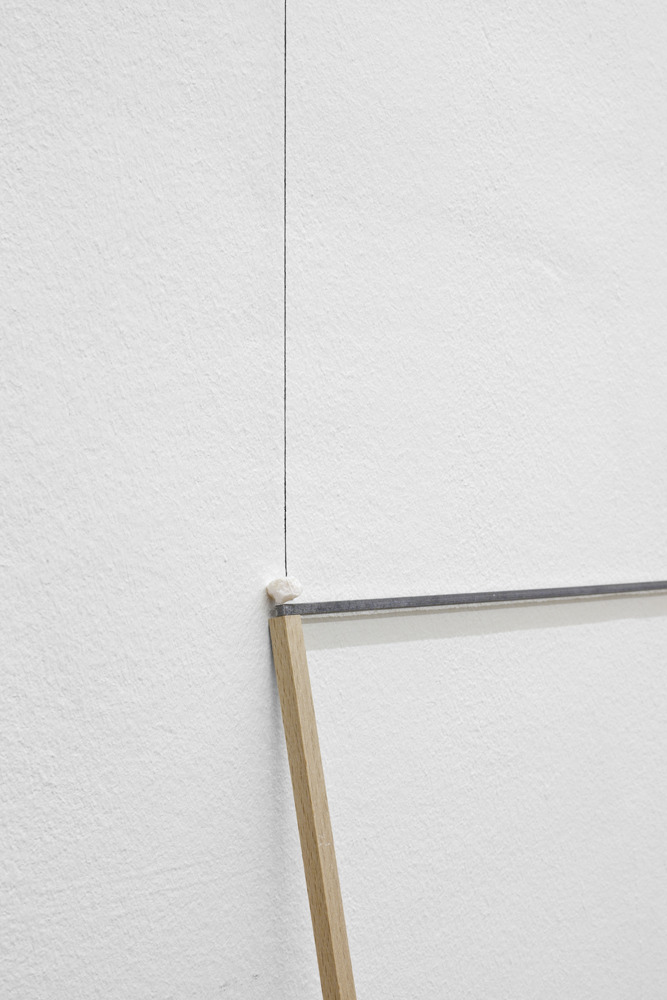
Jong Oh, Line Sculpture #8, 2015 ©Jong Oh
The geometric patterns, resembling grids,
evoke a sense of cool detachment, yet subtle warmth is simultaneously
introduced through handcrafted details. For example, rather than using
machine-processed black thread, Oh deliberately opts for white thread and
manually applies paint or charcoal powder to its surface.
The artist explains that his incorporation
of handcrafting stems from his desire to avoid evoking the serious and
mechanical processes associated with American minimalism. Instead, he aims to
create “warm geometric works,” reflecting a long-held aspiration in his
practice.
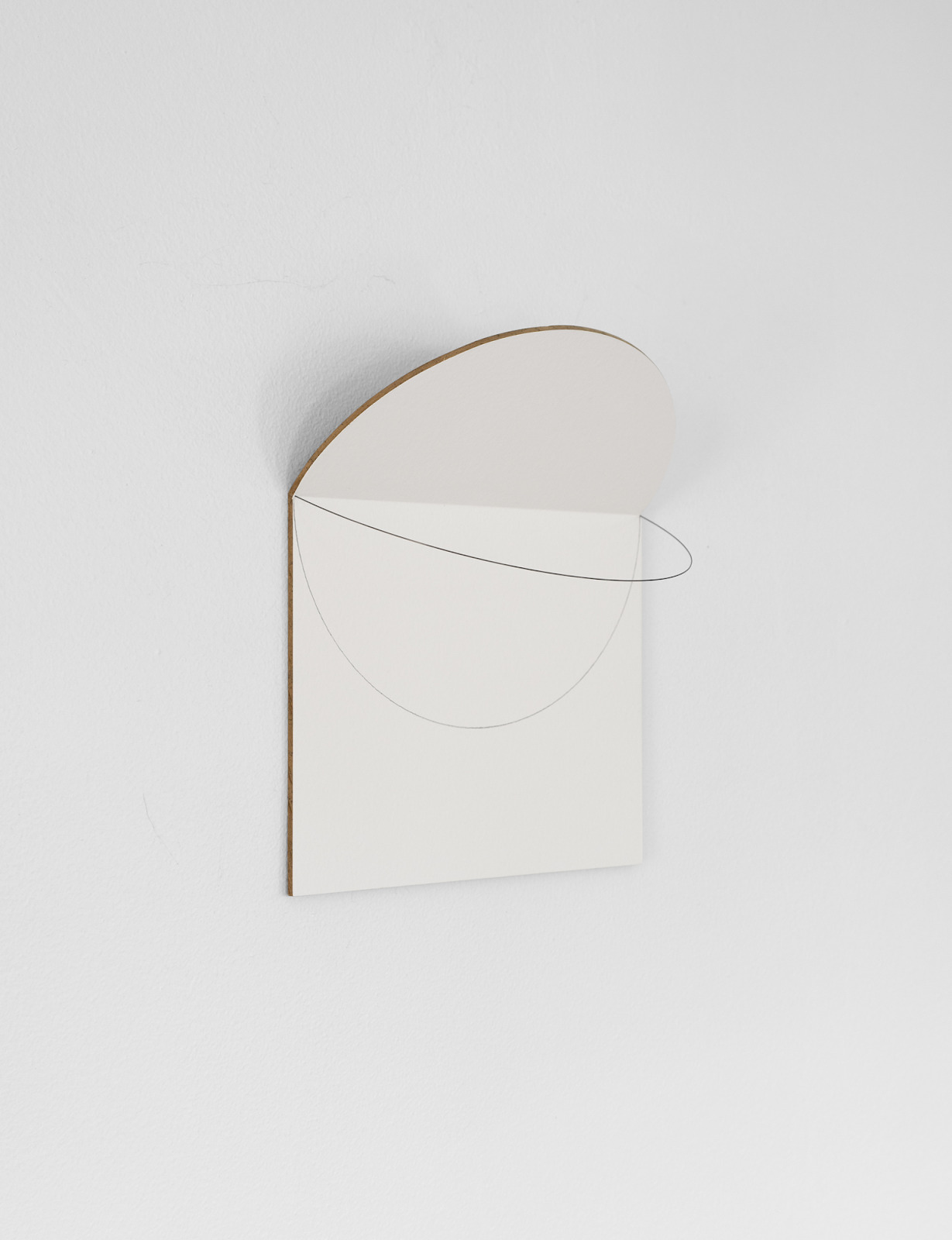 Jong Oh, Folding
Drawing #21, 2019 ©Jong Oh
Jong Oh, Folding
Drawing #21, 2019 ©Jong OhWhile the ‘Line Sculpture’ series
emphasizes linear elements, Jong Oh's ‘Folding Drawing’ series (2016–) reveals
the artist's exploration of planes. Created on a relatively smaller scale,
‘Folding Drawing’ investigates profound dimensions through the concept of
"folding" planes.
Using wooden panels as the primary
sculptural material, Oh crafts various folded forms and paints them white. Thin
black chains or wires are then installed alongside, creating the impression of
a three-dimensional drawing unfolding on a white canvas.
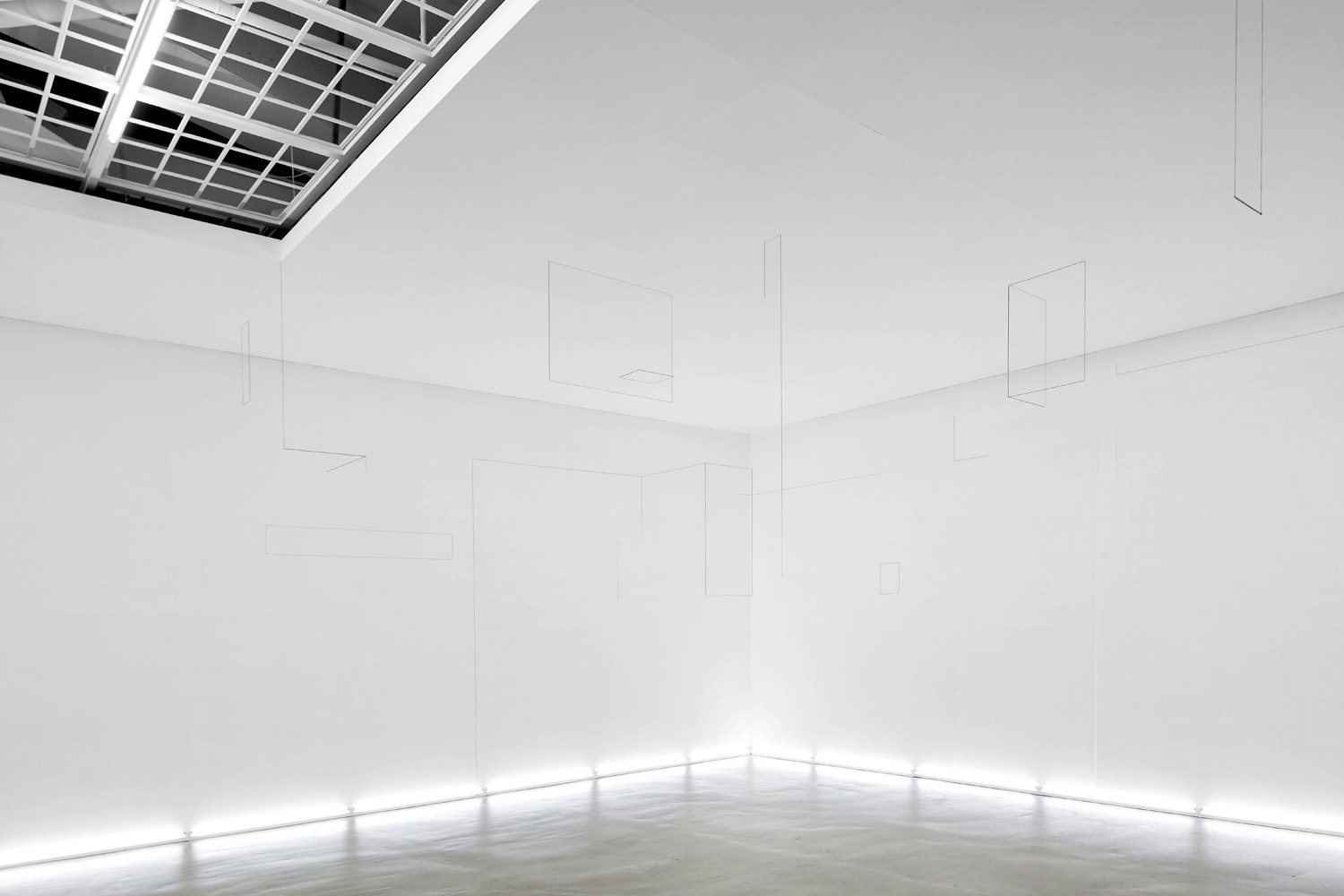 오종, 〈Room Drawing (monochrome) #4〉, 2018 ©아트선재센터. 사진: 김연제
오종, 〈Room Drawing (monochrome) #4〉, 2018 ©아트선재센터. 사진: 김연제Extending from ‘Line Sculpture’ and
‘Folding Drawing’, Jong Oh’s ‘Room Drawing’ series (2016–) takes the entirety
of the given exhibition space as its subject. This work begins with a
meticulous observation of the space, examining not only its architectural
elements but also subtle traces left by its use, as a way to engage in a
dialogue with the space.
Oh describes sensing a quiet “resonance”
through his interaction with the space. In response, he creates ‘Room
Drawing’—a three-dimensional geometric installation composed of the same
delicate and minimal materials used in his earlier works. The installation
floats throughout the space, guiding the viewer’s gaze and reshaping their
perception of the environment.
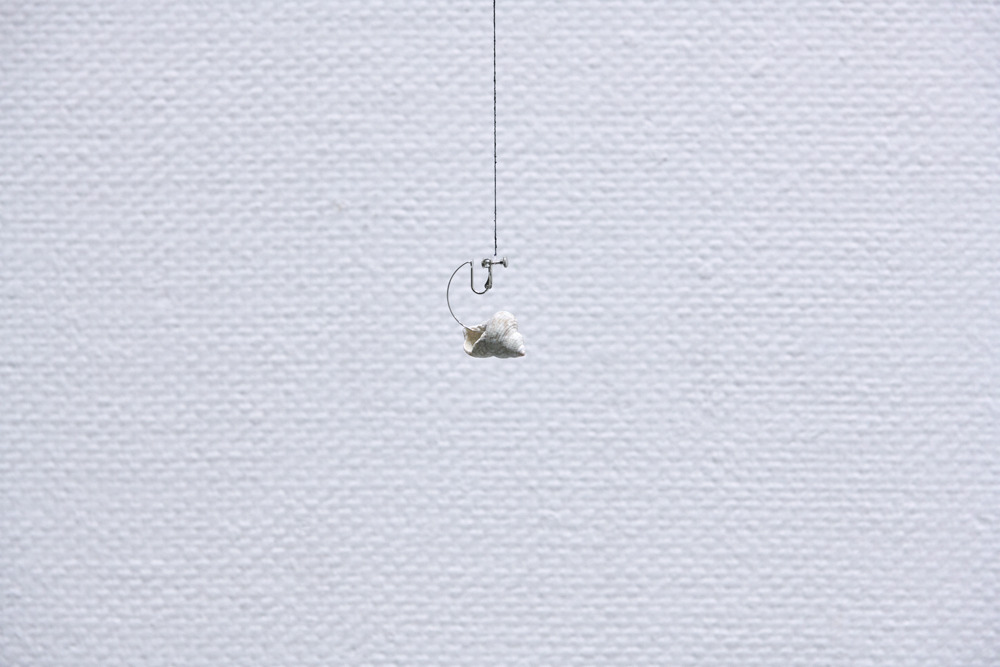 Jong Oh, Room
Drawing (found objects) #1, 2018 ©Spiral Wacoal Art Center. Photo: Junpei
Kato.
Jong Oh, Room
Drawing (found objects) #1, 2018 ©Spiral Wacoal Art Center. Photo: Junpei
Kato.In Room Drawing (found objects) #1
(2018), Jong Oh revisits his early ‘Found gesture’ series by incorporating
objects he stumbled upon by chance. During the exhibition, the artist completed
the work using everyday items collected from the streets, such as tree
branches, padlocks, parts of umbrellas, springs, rocks, chains, and flowers.
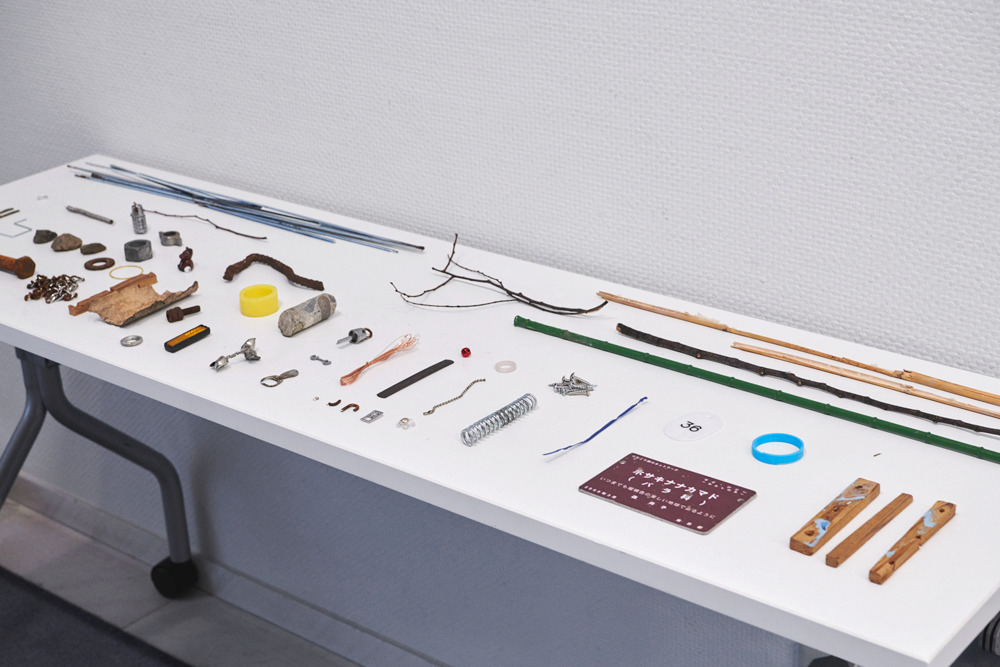 Jong Oh, Room
Drawing (found objects) #1, 2018 ©Spiral Wacoal Art Center. Photo: Junpei
Kato.
Jong Oh, Room
Drawing (found objects) #1, 2018 ©Spiral Wacoal Art Center. Photo: Junpei
Kato.Rather than presenting a finished form, the
work unfolded like a narrative, with the artist adding newly gathered objects
each morning. As a result, the piece transformed daily throughout the
exhibition period, allowing the viewers to witness the evolving process as part
of the artwork itself.
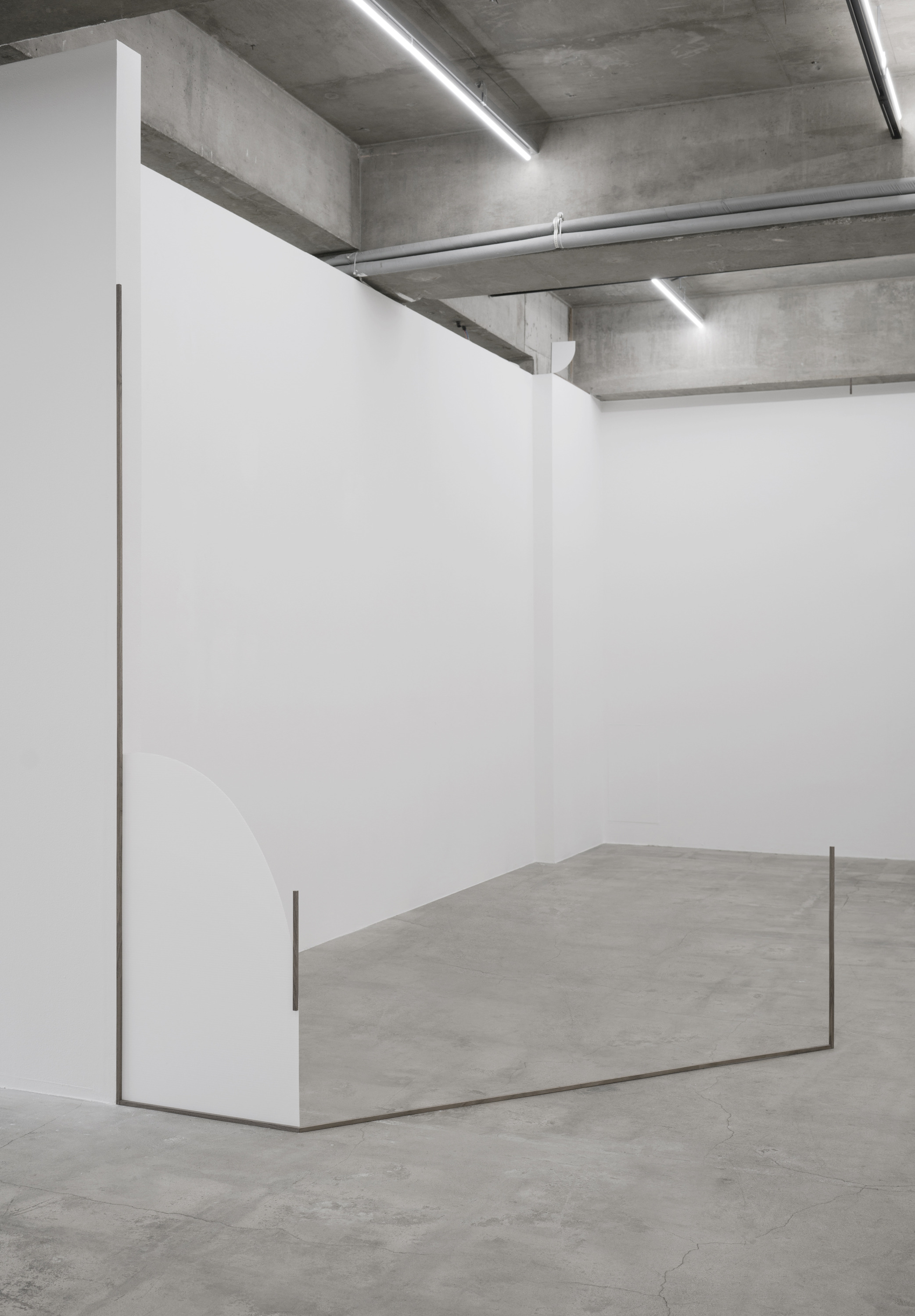 Jong Oh, Room
Drawing (double sided) #1, 2022 ©Jong Oh
Jong Oh, Room
Drawing (double sided) #1, 2022 ©Jong OhThe ‘Room Drawing’ series traverses space
with linear elements, much like the ‘Line Sculpture’ series, while also forming
small, condensed spatial sensations created by the folding of planes,
reminiscent of the ‘Folding Drawing’ series. Furthermore, the series extends to
interact with architectural elements such as corners, windows, and columns,
guiding viewers toward a more spatial dimension of appreciation.
As viewers follow the drawings Jong Oh
creates throughout the space, the interplay between the work and its
surroundings appears to change depending on their perspective. Lines may
transform into planes, and vice versa, creating an illusion of stepping into a
mutable, ever-shifting space.
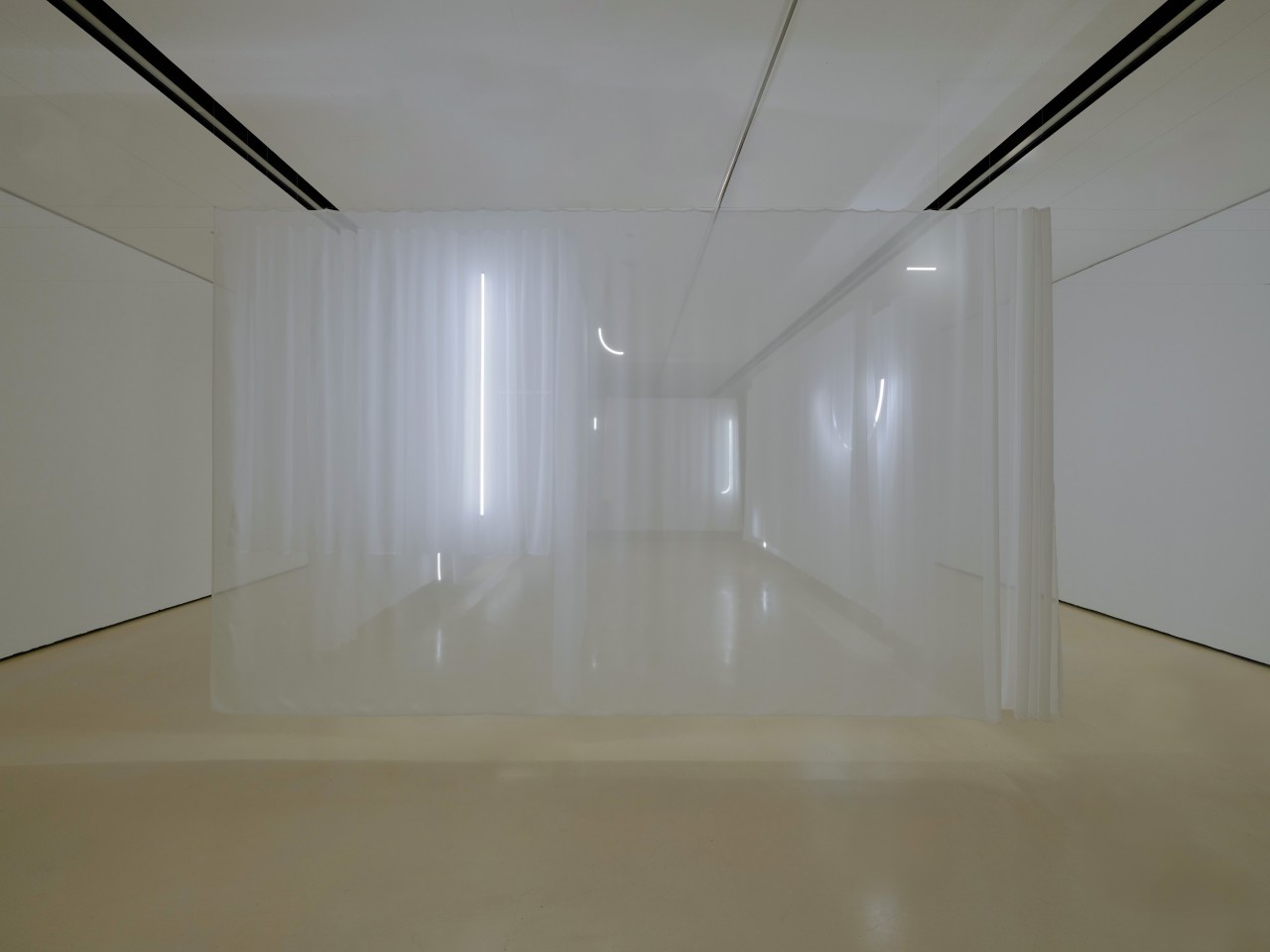 Jong Oh, Light
Drawing (room) #1, 2024, Installation view of 《white》
(Perigee Gallery, 2024) ©Jong Oh. Photo: Kim Kyungtae.
Jong Oh, Light
Drawing (room) #1, 2024, Installation view of 《white》
(Perigee Gallery, 2024) ©Jong Oh. Photo: Kim Kyungtae.In his practice of visually translating the
invisible sensations inherent in space into constructive forms, Jong Oh has
recently introduced LED lighting as a new material. Last year, in his solo
exhibition 《white》 at Perigee
Gallery, the artist explored the theme of "white" through the
installation Light Drawing (room) #1 (2024), composed of
white light and fabric.
The semi-transparent white fabric surrounds
the LED light installations, which blend straight and curved lines to emit a
soft white glow, dividing the space. The interplay of light and fabric at the
boundaries creates a rich array of visual experiences. Depending on the degree
of fabric overlap and the viewer's movement, the light may appear fully bright,
completely obscured, or even fragmented into multiple beams, offering a dynamic
and immersive sensory encounter.
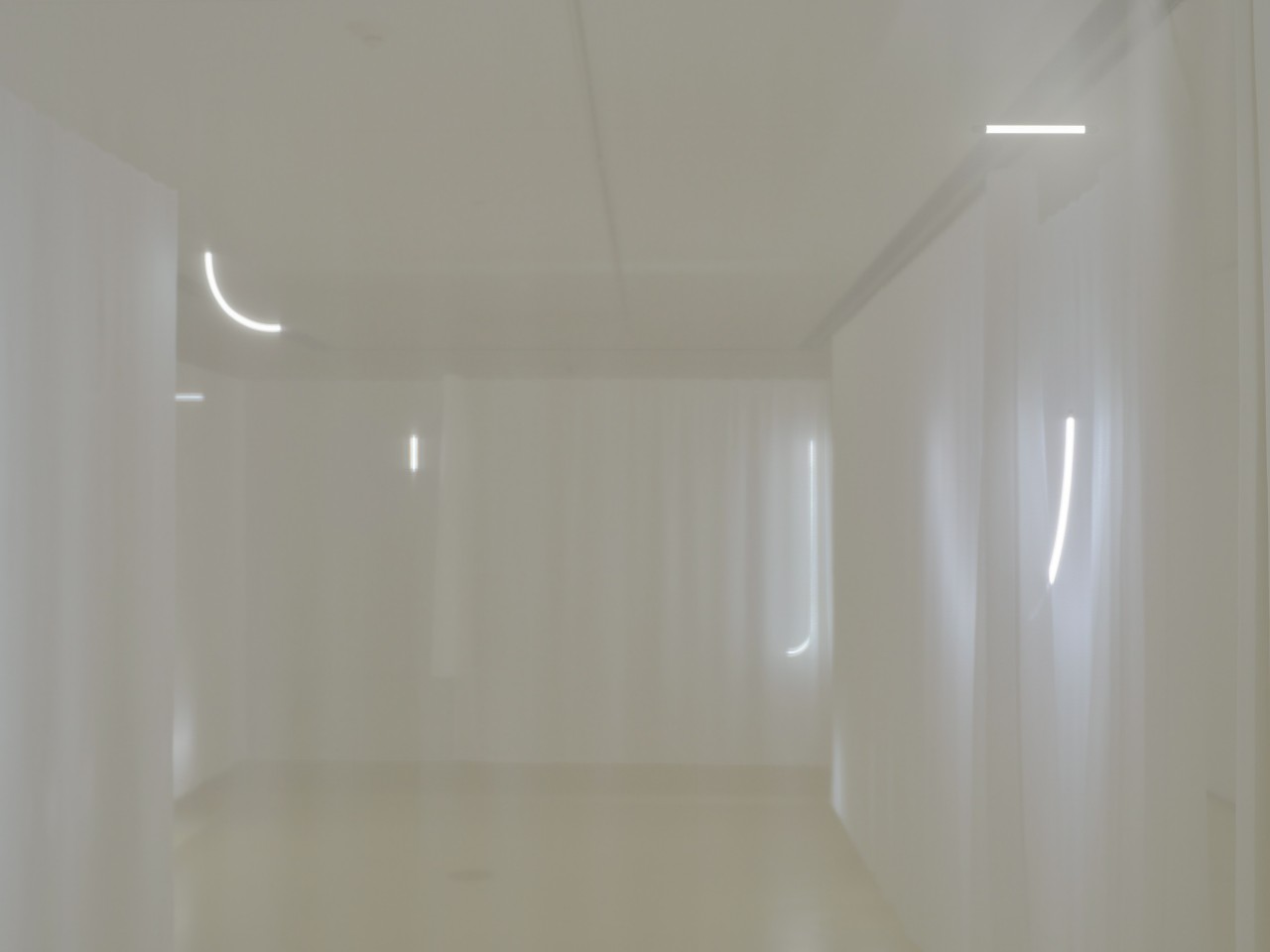 Jong Oh, Light
Drawing (room) #1, 2024, Installation view of 《white》
(Perigee Gallery, 2024) ©Jong Oh. Photo: Kim Kyungtae.
Jong Oh, Light
Drawing (room) #1, 2024, Installation view of 《white》
(Perigee Gallery, 2024) ©Jong Oh. Photo: Kim Kyungtae.A key element of this work is the cyclical
structure created by the interplay of light and fabric. The light within the
space is not fixed but constantly changes depending on the movement and gaze of
the viewer. Through this, Oh encourages the viewers to feel the rhythm and
resonance inherent in the space.
In this way, Jong Oh’s work begins with a
dialogue between the given space and the artist, translating the sensed
"resonance of space" into a sculptural form. The works he creates
guide the viewers to detect some invisible rhythm or resonance within the
space, shedding new light on the diverse sensory dimensions of the environment.
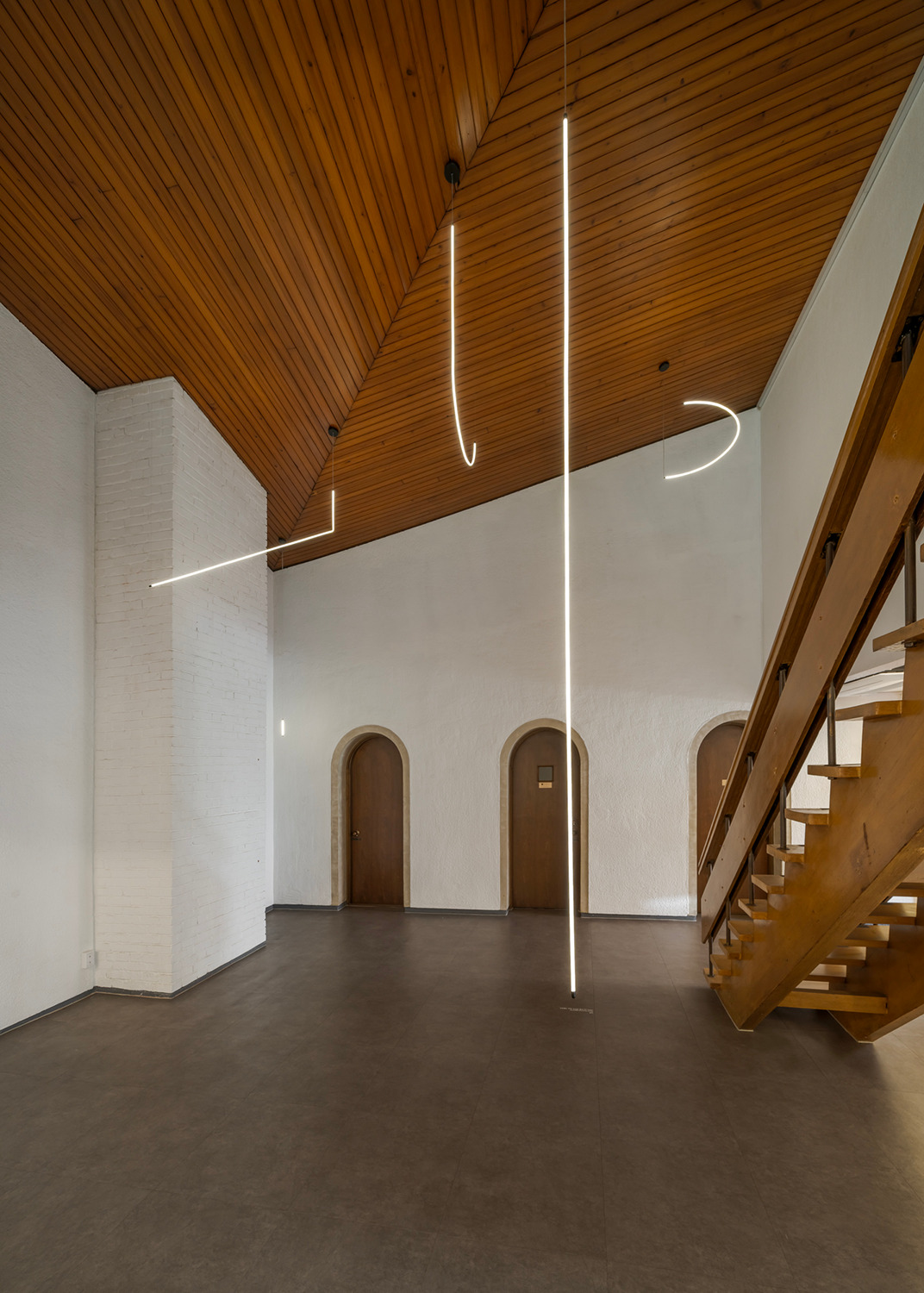 Jong Oh, Room
Drawing (light) #1, 2023 ©Choi Man Lin Museum.
Jong Oh, Room
Drawing (light) #1, 2023 ©Choi Man Lin Museum.“I begin all my artworks by first calmly
observing the space I’m working in, and therefore, sensing and understanding
the reverberations of the architectural space is extremely important for my works.
When I first come into contact with a new space, I always get a sense of these
low reverberations, which likely come from the weight of the stone or steel
used in its construction, or the heavy geometric structures of the straight
lines of the space and the heavy sense of rhythm that they create.
Regardless, rather than completely
monopolizing the space, this echo, as a form of emptiness, wraps itself around
and caresses everything that remains in the space while vibrating lightly and
softly. Within the freedom permitted by this vibration, I forge ahead with my work
as if attempting to complete this tone.” (Jong Oh, Artist’s Note)
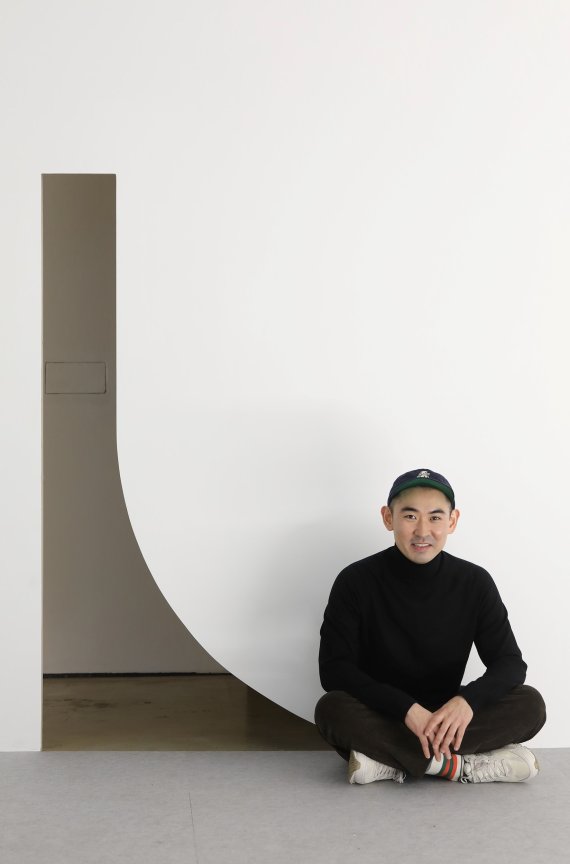
Artist Jong Oh ©Newsis
Jong Oh received his B.F.A in Sculpture
from Hongik University in Seoul and M.F.A in Fine Arts from School of Visual
Arts in New York. His major solo exhibitions include 《white》 (Perigee Gallery, Seoul, 2024), 《Merestone》
(Sabrina Amrani Gallery, Madrid, Spain, 2023), 《First Echo》 (ONE AND J. Gallery, Seoul, 2022),
《Double Sided》 (CR Collective,
Seoul, 2022), 《A Pause on the Arc》 (DOOSAN Gallery, Seoul, 2021), and 《Corner Dialogue》
(Seoul Museum of Art, Seoul, 2018).
He has also participated in numerous group
exhibitions, including 《Reconstructing Sequences》
(National Asia Culture Center, Gwangju, 2024), 《Off-Site》 (Art Sonje Center, Seoul, 2023), 《Post Media And Site》(Busan Museum of Art,
Busan, 2023), and 《Negative Space》 (ZKM, Karlsruhe, Germany, 2019).
Oh received the 33rd Kim Se-Jung Young
Sculptor Award in 2022 and the Excellence Prize at the 20th SONGEUN Art Award
in 2021. Also participated in the artist-in-residence program of DOOSAN
Residency, New York (2021) and many more.




